Translation Memory (TM) Machine Translation(MT) Computer Aided Translation
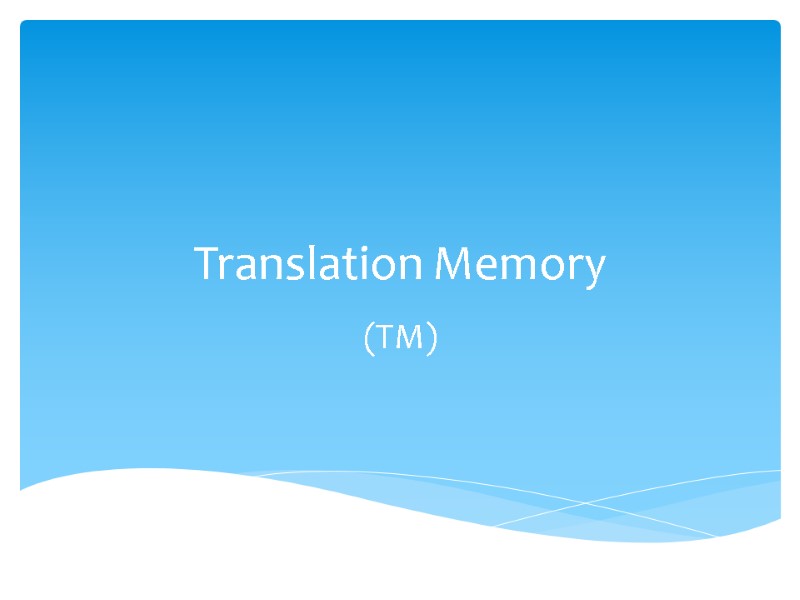
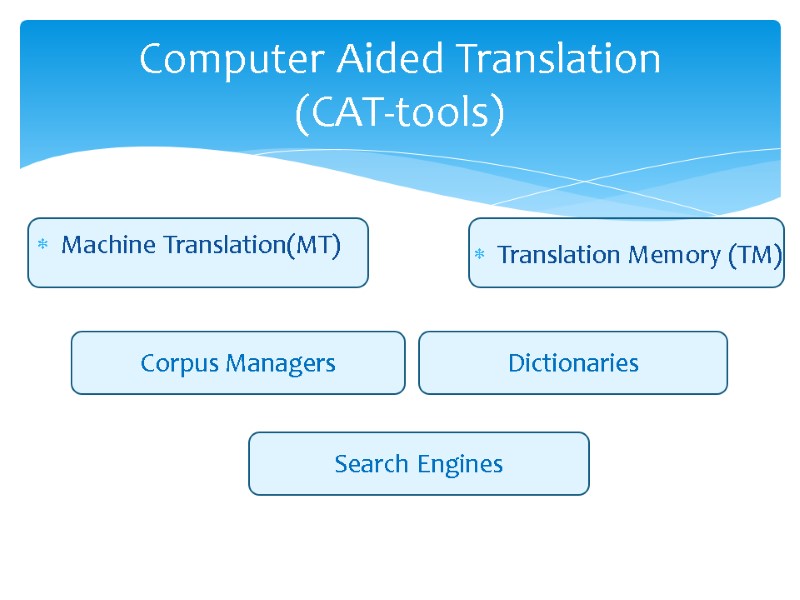
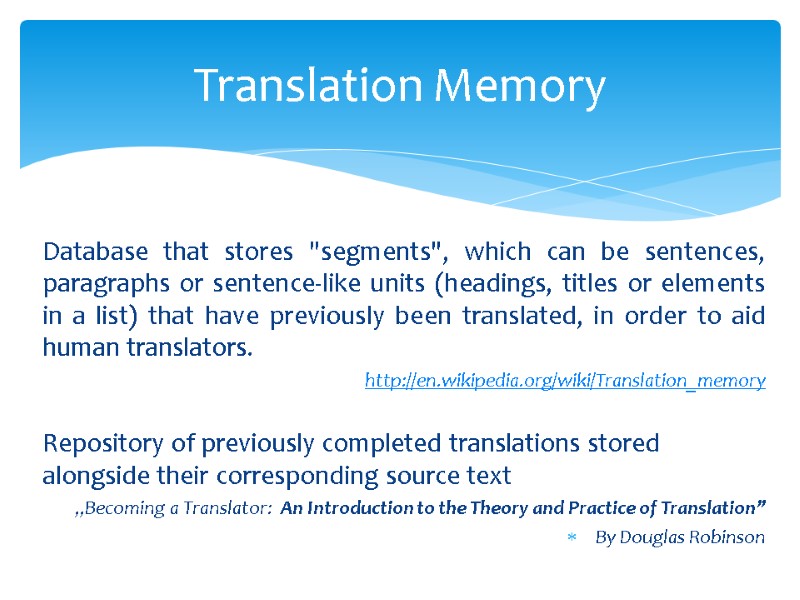
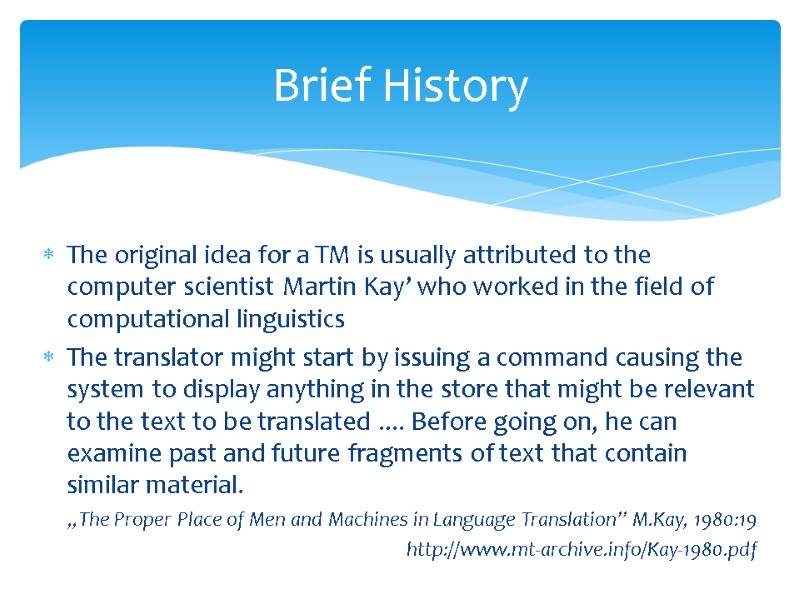
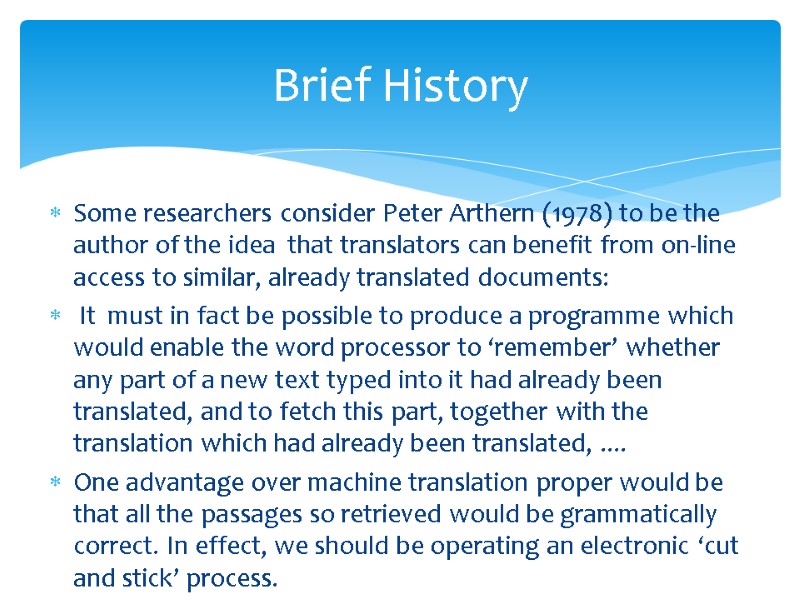
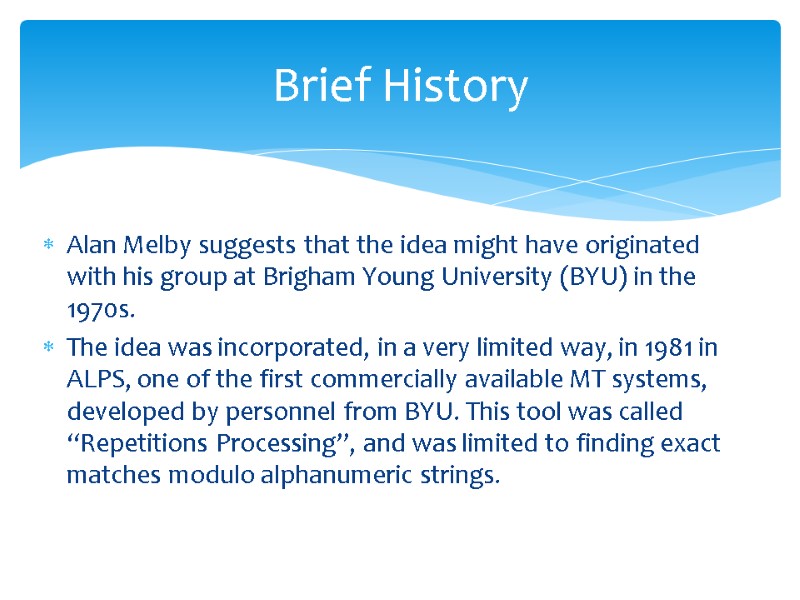
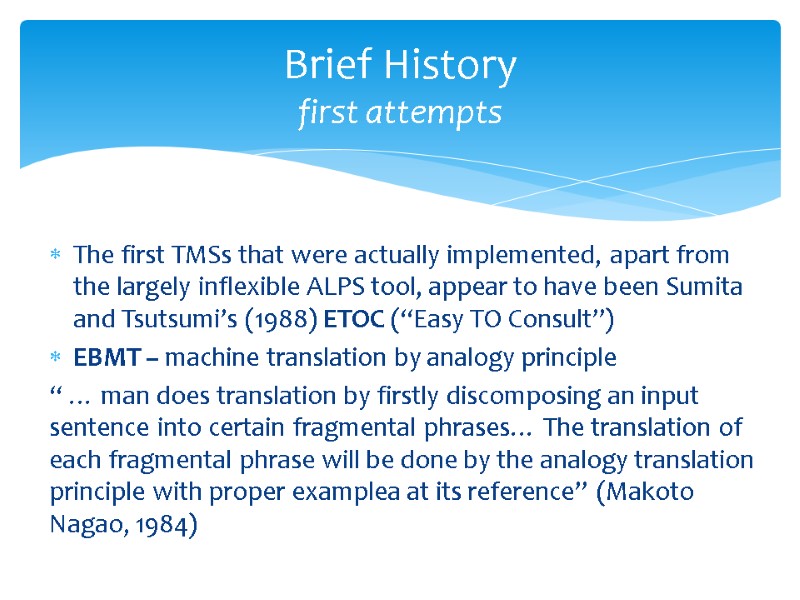
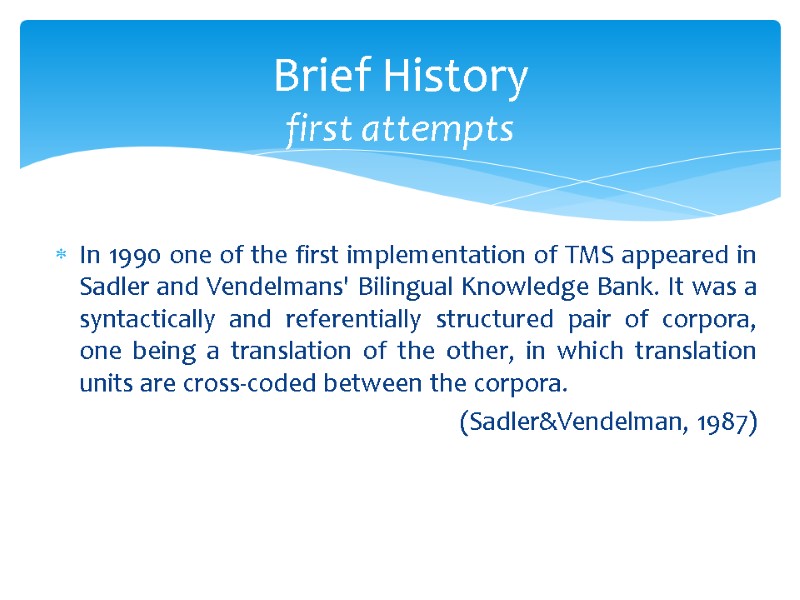
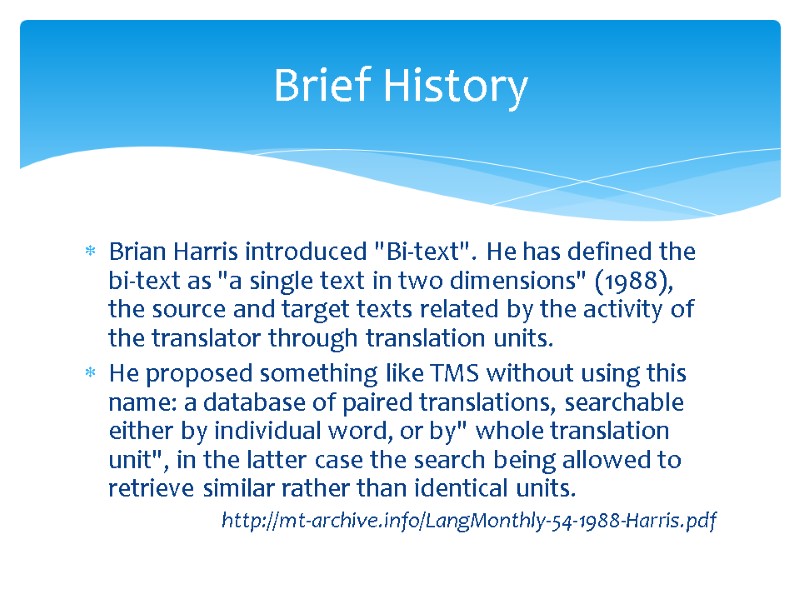
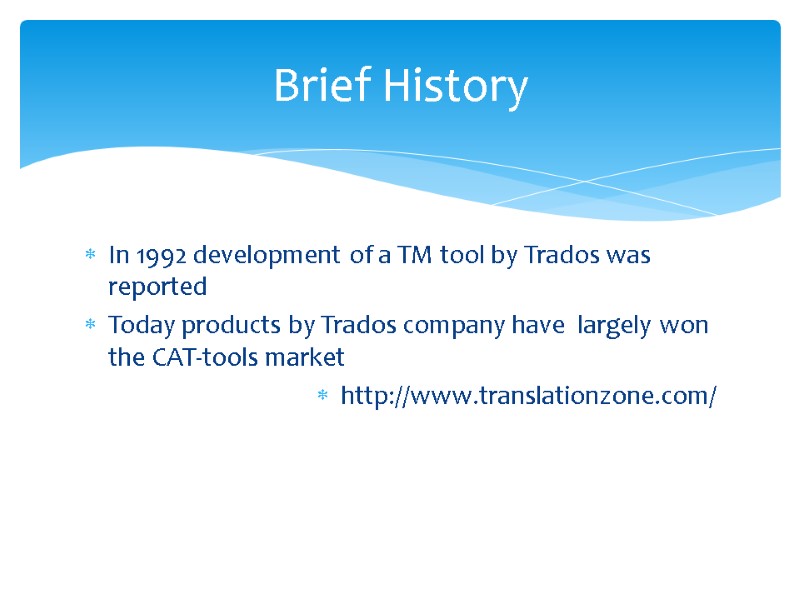
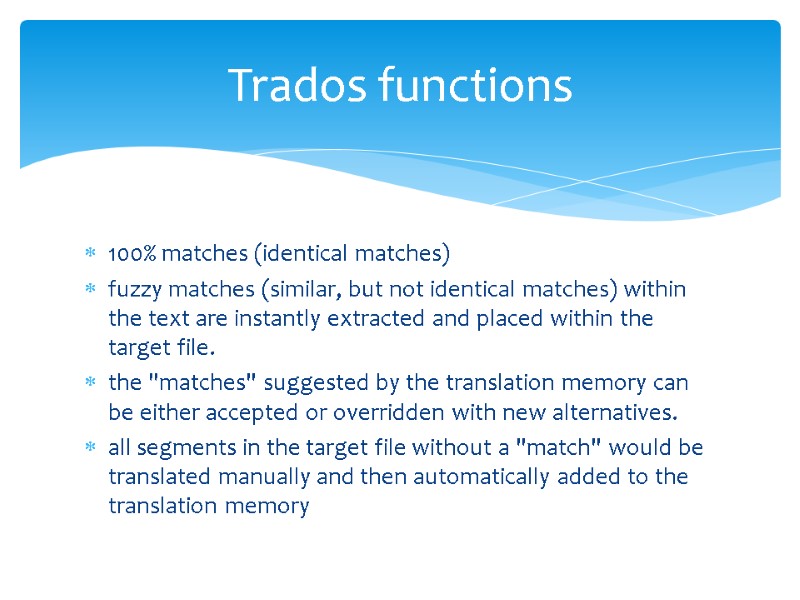
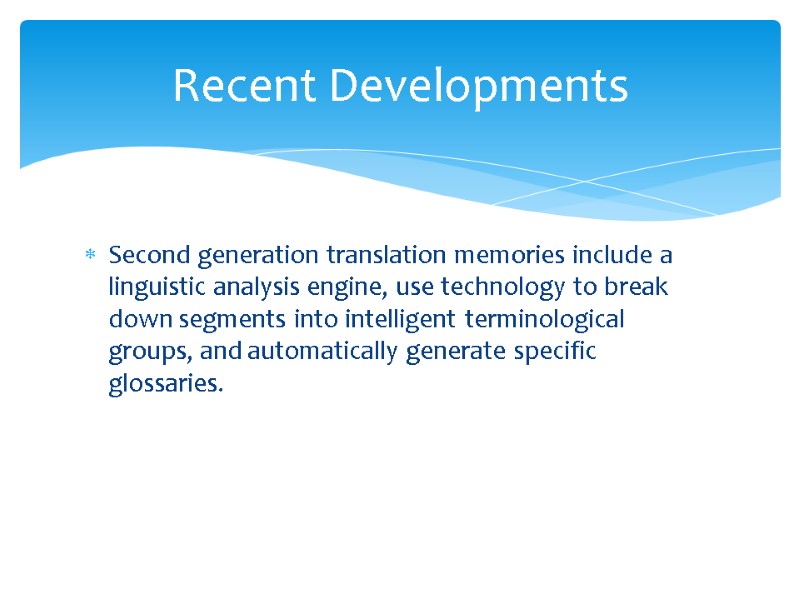
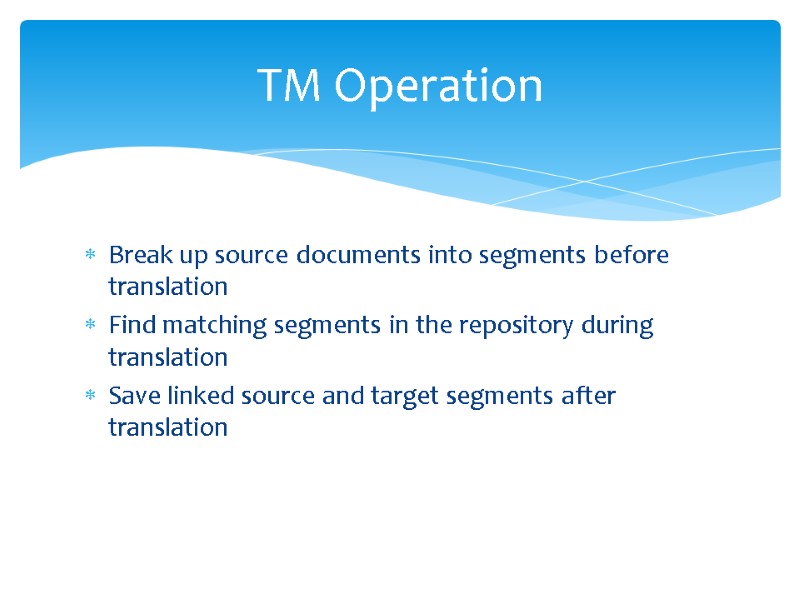
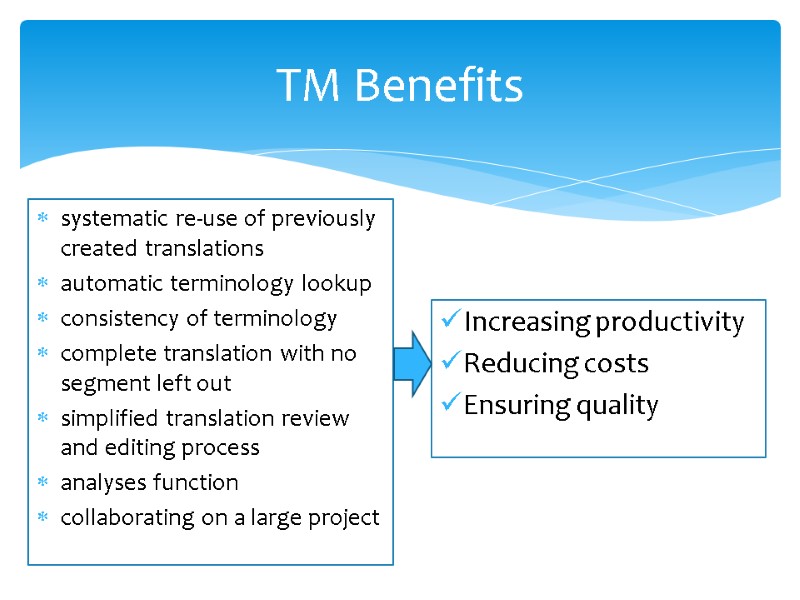
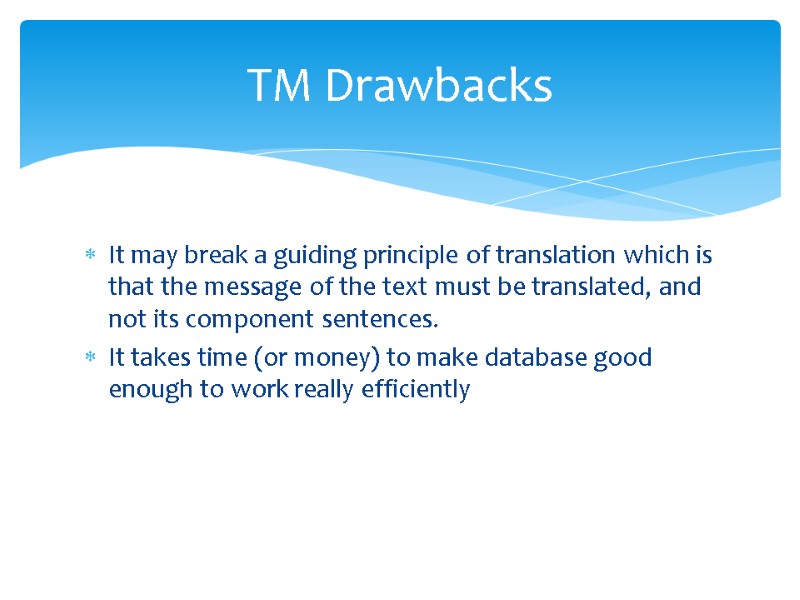
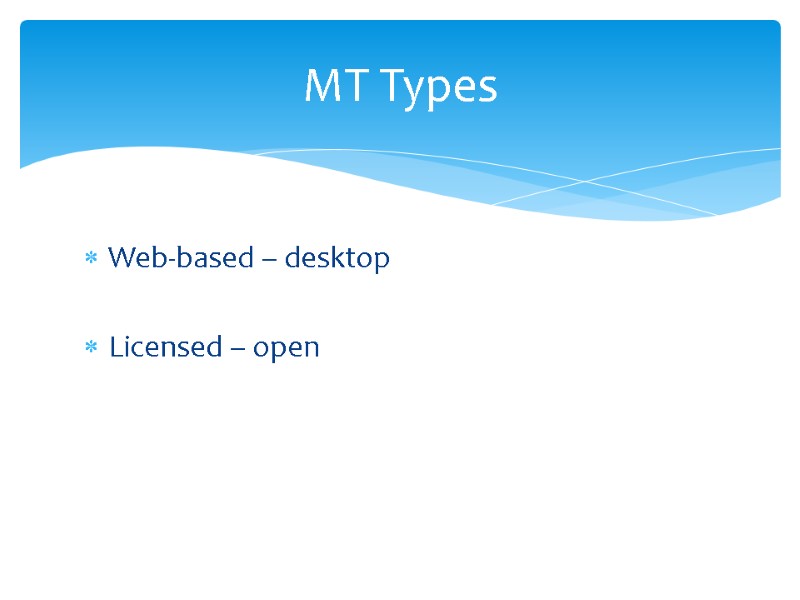

14756-translation_memory.ppt
- Количество слайдов: 17
 Translation Memory (TM)
Translation Memory (TM)
 Machine Translation(MT) Computer Aided Translation (CAT-tools) Translation Memory (TM) Search Engines Dictionaries Corpus Managers
Machine Translation(MT) Computer Aided Translation (CAT-tools) Translation Memory (TM) Search Engines Dictionaries Corpus Managers
 Database that stores "segments", which can be sentences, paragraphs or sentence-like units (headings, titles or elements in a list) that have previously been translated, in order to aid human translators. http://en.wikipedia.org/wiki/Translation_memory Repository of previously completed translations stored alongside their corresponding source text „Becoming a Translator: An Introduction to the Theory and Practice of Translation” By Douglas Robinson Translation Memory
Database that stores "segments", which can be sentences, paragraphs or sentence-like units (headings, titles or elements in a list) that have previously been translated, in order to aid human translators. http://en.wikipedia.org/wiki/Translation_memory Repository of previously completed translations stored alongside their corresponding source text „Becoming a Translator: An Introduction to the Theory and Practice of Translation” By Douglas Robinson Translation Memory
 The original idea for a TM is usually attributed to the computer scientist Martin Kay’ who worked in the field of computational linguistics The translator might start by issuing a command causing the system to display anything in the store that might be relevant to the text to be translated .... Before going on, he can examine past and future fragments of text that contain similar material. „The Proper Place of Men and Machines in Language Translation” M.Kay, 1980:19 http://www.mt-archive.info/Kay-1980.pdf Brief History
The original idea for a TM is usually attributed to the computer scientist Martin Kay’ who worked in the field of computational linguistics The translator might start by issuing a command causing the system to display anything in the store that might be relevant to the text to be translated .... Before going on, he can examine past and future fragments of text that contain similar material. „The Proper Place of Men and Machines in Language Translation” M.Kay, 1980:19 http://www.mt-archive.info/Kay-1980.pdf Brief History
 Some researchers consider Peter Arthern (1978) to be the author of the idea that translators can benefit from on-line access to similar, already translated documents: It must in fact be possible to produce a programme which would enable the word processor to ‘remember’ whether any part of a new text typed into it had already been translated, and to fetch this part, together with the translation which had already been translated, .... One advantage over machine translation proper would be that all the passages so retrieved would be grammatically correct. In effect, we should be operating an electronic ‘cut and stick’ process. Brief History
Some researchers consider Peter Arthern (1978) to be the author of the idea that translators can benefit from on-line access to similar, already translated documents: It must in fact be possible to produce a programme which would enable the word processor to ‘remember’ whether any part of a new text typed into it had already been translated, and to fetch this part, together with the translation which had already been translated, .... One advantage over machine translation proper would be that all the passages so retrieved would be grammatically correct. In effect, we should be operating an electronic ‘cut and stick’ process. Brief History
 Alan Melby suggests that the idea might have originated with his group at Brigham Young University (BYU) in the 1970s. The idea was incorporated, in a very limited way, in 1981 in ALPS, one of the first commercially available MT systems, developed by personnel from BYU. This tool was called “Repetitions Processing”, and was limited to finding exact matches modulo alphanumeric strings. Brief History
Alan Melby suggests that the idea might have originated with his group at Brigham Young University (BYU) in the 1970s. The idea was incorporated, in a very limited way, in 1981 in ALPS, one of the first commercially available MT systems, developed by personnel from BYU. This tool was called “Repetitions Processing”, and was limited to finding exact matches modulo alphanumeric strings. Brief History
 The first TMSs that were actually implemented, apart from the largely inflexible ALPS tool, appear to have been Sumita and Tsutsumi’s (1988) ETOC (“Easy TO Consult”) EBMT – machine translation by analogy principle “ … man does translation by firstly discomposing an input sentence into certain fragmental phrases… The translation of each fragmental phrase will be done by the analogy translation principle with proper examplea at its reference” (Makoto Nagao, 1984) Brief History first attempts
The first TMSs that were actually implemented, apart from the largely inflexible ALPS tool, appear to have been Sumita and Tsutsumi’s (1988) ETOC (“Easy TO Consult”) EBMT – machine translation by analogy principle “ … man does translation by firstly discomposing an input sentence into certain fragmental phrases… The translation of each fragmental phrase will be done by the analogy translation principle with proper examplea at its reference” (Makoto Nagao, 1984) Brief History first attempts
 In 1990 one of the first implementation of TMS appeared in Sadler and Vendelmans' Bilingual Knowledge Bank. It was a syntactically and referentially structured pair of corpora, one being a translation of the other, in which translation units are cross-coded between the corpora. (Sadler&Vendelman, 1987) Brief History first attempts
In 1990 one of the first implementation of TMS appeared in Sadler and Vendelmans' Bilingual Knowledge Bank. It was a syntactically and referentially structured pair of corpora, one being a translation of the other, in which translation units are cross-coded between the corpora. (Sadler&Vendelman, 1987) Brief History first attempts
 Brian Harris introduced "Bi-text". He has defined the bi-text as "a single text in two dimensions" (1988), the source and target texts related by the activity of the translator through translation units. He proposed something like TMS without using this name: a database of paired translations, searchable either by individual word, or by" whole translation unit", in the latter case the search being allowed to retrieve similar rather than identical units. http://mt-archive.info/LangMonthly-54-1988-Harris.pdf Brief History
Brian Harris introduced "Bi-text". He has defined the bi-text as "a single text in two dimensions" (1988), the source and target texts related by the activity of the translator through translation units. He proposed something like TMS without using this name: a database of paired translations, searchable either by individual word, or by" whole translation unit", in the latter case the search being allowed to retrieve similar rather than identical units. http://mt-archive.info/LangMonthly-54-1988-Harris.pdf Brief History
 In 1992 development of a TM tool by Trados was reported Today products by Trados company have largely won the CAT-tools market http://www.translationzone.com/ Brief History
In 1992 development of a TM tool by Trados was reported Today products by Trados company have largely won the CAT-tools market http://www.translationzone.com/ Brief History
 100% matches (identical matches) fuzzy matches (similar, but not identical matches) within the text are instantly extracted and placed within the target file. the "matches" suggested by the translation memory can be either accepted or overridden with new alternatives. all segments in the target file without a "match" would be translated manually and then automatically added to the translation memory Trados functions
100% matches (identical matches) fuzzy matches (similar, but not identical matches) within the text are instantly extracted and placed within the target file. the "matches" suggested by the translation memory can be either accepted or overridden with new alternatives. all segments in the target file without a "match" would be translated manually and then automatically added to the translation memory Trados functions
 Second generation translation memories include a linguistic analysis engine, use technology to break down segments into intelligent terminological groups, and automatically generate specific glossaries. Recent Developments
Second generation translation memories include a linguistic analysis engine, use technology to break down segments into intelligent terminological groups, and automatically generate specific glossaries. Recent Developments
 Break up source documents into segments before translation Find matching segments in the repository during translation Save linked source and target segments after translation TM Operation
Break up source documents into segments before translation Find matching segments in the repository during translation Save linked source and target segments after translation TM Operation
 TM Benefits systematic re-use of previously created translations automatic terminology lookup consistency of terminology complete translation with no segment left out simplified translation review and editing process analyses function collaborating on a large project Increasing productivity Reducing costs Ensuring quality
TM Benefits systematic re-use of previously created translations automatic terminology lookup consistency of terminology complete translation with no segment left out simplified translation review and editing process analyses function collaborating on a large project Increasing productivity Reducing costs Ensuring quality
 It may break a guiding principle of translation which is that the message of the text must be translated, and not its component sentences. It takes time (or money) to make database good enough to work really efficiently TM Drawbacks
It may break a guiding principle of translation which is that the message of the text must be translated, and not its component sentences. It takes time (or money) to make database good enough to work really efficiently TM Drawbacks
 Web-based – desktop Licensed – open MT Types
Web-based – desktop Licensed – open MT Types

